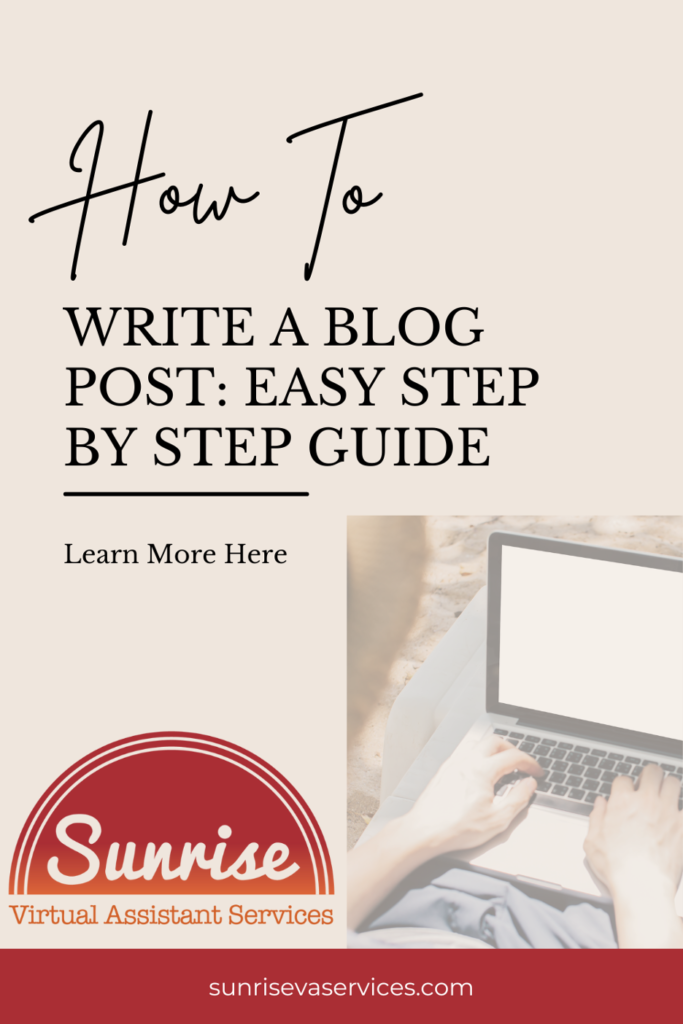It can be difficult to figure out how to write your first blog post if you’re new to blogging. However, there’s no need to worry – this step-by-step guide will show you exactly how it’s done.
We’ll explain the writing process behind creating engaging blog posts, how to include SEO so your target audience can find your posts, and how to promote your posts to get the most out of them.
First Step: Choosing a Topic
Many people new to blogging make the mistake of starting their new blog post with a long-winded introduction that rehashes the post’s specific topic and provides little new important information. While it is important to give your readers an overview of what they can expect from your post, it is also essential to be concise and to get to the point quickly, to keep your readers’ attention.
A better approach is to start with a brief introduction in the first paragraph, which provides just enough information to pique your reader’s interest and then get right into the heart of your post. By starting strong, you will keep your reader’s attention focused on your content and increase the chances that they will stick with you until the end.
A great headline is also essential for capturing your reader’s attention and getting them to click through to read your post. Although developing a compelling headline may take a bit of practice, it is well worth the effort. This can be the difference between success and failure regarding increasing readership.
The type of blog post you wish to write also plays an important role and will define your post’s overall tone and flow (as well as the user experience).
What Different Types Of Blog Posts Are There?
As a business, blog posts are a great way to attract new customers and show off your company’s thought leadership. But what types of blog posts are most effective in achieving these goals? In general, businesses should consider three types of blog posts: how-to guides, lists, and interviews.
How-to guides offer step-by-step instructions on how to do something related to your industry. They position you as an expert on the topic and can be extremely helpful for potential customers looking for solutions to their problems. Lists, on the other hand, are a great way to grab attention with catchy headlines and provide valuable information in an easily digestible format. Finally, interviews are a great way to showcase your company’s industry experts and thought leaders. By featuring someone else’s voice on your blog, you can add credibility to your brand and build relationships with other leaders in your field.
All three of these types of blog posts can be effective in different ways, so it’s important to experiment and see what works best for your business. Ultimately, the goal is to produce valuable, informative, and relevant content for your target audience. By doing this, you’ll be well on your way to attracting new customers and growing your business.
Second Step: Writing An Informative Body
Once you have chosen a topic and type of blog post, it’s time to start writing the body of your post. This is where the real meat of your blog post lies, and it’s vital to ensure that the great content you are writing is engaging and informative. If your readers are learning (while being entertained), your website retention will improve.
When writing a post, it’s a good idea to structure your content in a way that is easy for readers to follow. This means including headings and subheadings to break up your post into sections and providing relevant images or other visuals where appropriate.
When writing the body of your post, be sure to focus on providing helpful information that is relevant to your topic. While injecting a bit of your personality and unique perspective into the post is important, try to avoid lengthy stories or anecdotes that are not directly related to the point you are trying to make.
How To Use SEO Within Blog Posts
Additionally, it is important to include SEO strategies within your post. SEO, or search engine optimization, is the practice of incorporating specific keywords and phrases into your blog posts that will help your content to appear higher in search engine rankings.
Some effective SEO techniques for blog posts include:
– Including relevant keywords in headings and subheadings
– Relevant keywords sprinkled throughout the post
– Using external links to authoritative websites
– Internal link building by linking to other posts on your blog
By utilizing these SEO techniques, you can ensure that your content is optimized for search engine visibility and will get in front of more readers. This is essential for any business looking to increase its readership and online presence. While fine-tuning your SEO and writing skills require a lot of time, the entire process is a worthy investment.
Helpful SEO Tools
A good keyword research tool is critical for successful blog posts. A common mistake many new bloggers face is not using available tools to their advantage. Various tools are available to help you identify popular keywords and phrases related to your topic. This will help you optimize your content for search engine visibility and attract more readers.
You can also use Yoast SEO, a WordPress plugin, to optimize your blog post for SEO. Yoast lets you input essential keywords so that search engines can crawl through your content and index it more efficiently.
Using these tools, you can ensure that your blog post is optimized for SEO and will be seen by more readers. Pro tip: if you’re new to SEO and need help with how to use it, you can find helpful tutorials online or hire an SEO professional to help.
Step 3: How To Write A Blog Post With a Compelling Summary
The final step in writing a blog post is crafting a compelling summary. This will wrap up all of the points you have made and provide your readers with a solid call to action.
Your summary should be short yet informative and powerful. It should draw readers in and make them want to learn more about your topic by taking the next step you have suggested (which could be signing up for an email list, joining a forum or webinar, or making a purchase).
Finally, ensure that you end your summary with a solid call to action so that readers know exactly what they should do next. By doing this, you will ensure that your blog post is effective in driving readers toward the desired outcome.
Tips For Writing A Conclusion
When writing a blog post, it’s important to pay attention to the structure and flow of your content. This includes making sure that you have an effective conclusion. Here are some tips for crafting a remarkable conclusion:
A CTA can be purely textual. For example, you could include a sentence that reads: “Click here to find out more about X.” A CTA can also be an image or a video clip.
It is possible to generate interest and discussion by ending your blog post with a question – but you need to be careful. Questions should be thought-provoking, and they should be able to spark conversation.
In a summary conclusion, you can provide readers with a quick recap of what they’ve learned throughout the post.
You should summarize the main points of the article in a clear, concise way with actions associated (like mini-calls to action).
This strategy can be particularly effective in long, complex posts where readers may forget all the initial critical points.
By following these tips, you can ensure that your conclusion effectively wraps up the blog post and convinces readers to take action.
Step 4: Promoting on Social Networks
Once you have written the blog post and optimized it for search engine visibility, it’s time to promote it on social media.
Posting on social media is important in driving traffic to your blog. It can also help increase the visibility of your post, which will, in turn, help to grow your audience.
When posting on social media, you should use relevant hashtags and links so that readers can easily find your post. Additionally, it’s essential to be consistent in your posting frequency across all the social media accounts you use. This will ensure that readers keep up with your content and return for more.
Best Tips For Promoting Blog Posts On Social Media
When it comes to promoting blog posts on social media, there are a few tips you should keep in mind:
Choose the right platform: Different platforms have different audiences. Make sure that you are choosing the right ones for your content.
Include visuals: People respond better to visual content, so make sure that you use images and videos along with your posts.
Be creative: Try out new strategies and experiment with different types of content to see what works best.
Engage your followers: Don’t just post; interact with the people who comment on and share your posts.
By following these tips, you can ensure that you are effectively promoting your blog post and driving traffic to your website.
Conclusion
Writing a great blog post takes time and effort, but if done right, it can effectively engage with readers and drive traffic to your website. Creating compelling content is only the first step; you also need to ensure that it is properly optimized for SEO and that you promote it on the right platforms. Following the tips in this ultimate guide can help you create a successful blog post and ensure that your readers take the desired action.
Now that you know how to write an effective blog post, start crafting your content today! You may just be surprised at the results.
Still trying to figure out where to start? Consider working with a content marketing strategist or a content creation service, like Sunrise Virtual Assistant Services. Contact us today to learn more about developing quality content for your business blog.


